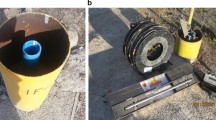Abstract
The present report highlights the methods used to monitor the rock mass behavior and performance of a cavern during excavation in order to verify and, if necessary, adjust the rock support to ensure safe construction at each stage of excavation. The present geotechnical monitoring practice for underground structures involves convergence monitoring with the help of optical targets and rock mass displacement with the help of borehole extensometers. More importantly, it involves detailed planning to finalize the position of each monitoring instrument, based on the location and orientation of geological features. It is equally important to ensure proper recording of monitoring data in order to analyze and take immediate action in case of any adverse situation. This requires dedicated high-end automated software, which can record, analyse and produce significant results from a large quantity of recorded data, to prevent what could otherwise be a catastrophic failure. Initially, geotechnical monitoring was carried out in the recently excavated zone of the cavern on a daily basis. Based on continuous monitoring data for at least 1 week, the frequency of subsequent monitoring can be decided. In most cases, the deformation of rock mass was considerably less than the alarming values which were calculated based on detailed design for different rock classes.



Similar content being viewed by others
References
Boon CW, Houlsby GT, Utili S (2015) Designing tunnel support in jointed rock masses via the DEM. Rock Mech Rock Eng 48(2):603–632
EIL (2010) Geotechnical monitoring and instrumentation. 4923/DSB/PUA/0014. Engineers India Ltd, New Delhi
EIL (2011) Design package for Cavern Storage. 4923/REP/PUA/0310. Engineers India Ltd, New Delhi
Grimstad E, Barton N (1993).Updating of the Q-system for NMT. In: Proceedings of international symposium on sprayed concrete-modern use of wet mix sprayed concrete for underground support, Fagernes, pp 46–66
Gunhan S (2015) Collaborative learning experience in a construction project site Trip. J Prof Issue Eng Educ Pract 141(1):1–5
Hu I, Liao H (2010) Method of up-slope mitigation priority for Alishan mountain road in Taiwan. J Perform Constr Facil 24(4):373–381
IS (1893) Part I: Indian standard criteria for earthquake resistant design of structures, Part I General provision and buildings
Jimeno CL (1997) Manual of tunnels and underground workings. Entorno Gráfico, Madrid. (in Spanish)
Kavvadas MJ (2003) Monitoring and modelling ground deformations during tunneling. Proceedings of 11th FIG Symposium on Deformation Measurements. Santorini, Greece
Lipponen A (2007) Applying GIS to assess the vulnerability of the paijanne water-conveyance tunnel in Finland. Environ Geol 53(3):493–499
Liu S (2006) Deformation measurements during the construction of large dam projects. Chin J Undergr Space Eng 6(Z2):1346–1348
Liu S, Zhao Z (2007) Deformation monitoring of 70 m span box girders of Hang-Zhou Bay Sea-Cross Bridge at construction stage. World Bridge 7(2):58–60
Mustafar MA, Simons WJF, Omar KM, Ambrosius BAC (2014) Monitoring of local deformations in north borneo, 6991, FIG congress 2014 engaging the challenges - enhancing the relevance, Kuala Lumpur, Malaysia 16–21 June 2014
Naha K, Srinivasan R, Jayaram S (1990) Structural evolution of the Peninsular Gneiss-an Early Precambrian migmatitic complex from South India. J of Geologische Rundschau Stuttgart 79(1):99–109
Prakash D, Singh CK, Singh PC, Deepak, Kumar A (2011) GIS based terrain modelling of the area NW of karimnagar, Southern India. Int J Remote Sens Appl 11(2):6–10
Taromi M, Eftekhari A, Hamidi JK, Aalianvari A (2016) A discrepancy between observed and predicted NATM tunnel behaviors and updating: a case study of the Subzkuh tunnel. Bull Eng Geol Environ. doi:10.1007/s-10064-016-0862-x
Xei W, Meng Y (2006) Design of safety monitoring information system of subway tunnel based on GIS. Railw Comput Appl 15(3):15–16
Author information
Authors and Affiliations
Corresponding author
Rights and permissions
About this article
Cite this article
Bhatkar, T., Mandal, A., Kumar, C. et al. Risk management by geotechnical monitoring for safe excavation of a large rock cavern: a case study. Bull Eng Geol Environ 76, 1209–1216 (2017). https://doi.org/10.1007/s10064-016-0963-6
Received:
Accepted:
Published:
Issue Date:
DOI: https://doi.org/10.1007/s10064-016-0963-6




